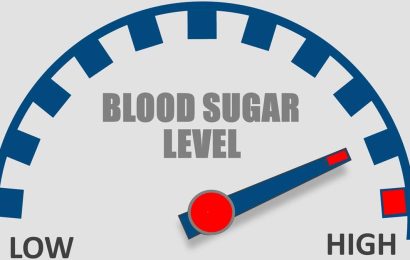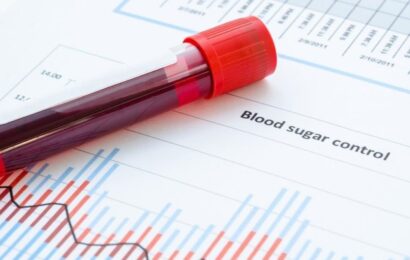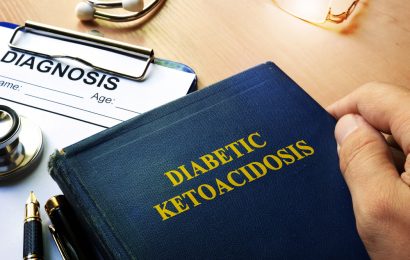You’ve pulled out your logbook and are taking off your jacket to bare your upper arm for the blood pressure cuff, when the nurse walks in and asks you to hold out a finger. “Does it matter that I had breakfast this morning?” you ask, trying to remember if you were supposed to fast before coming in, as she pricks your finger and collects a blood sample. “No, it doesn’t,” she says. “There; all done. The doctor will be in shortly to discuss your result.” And, indeed, several minutes later, your doctor walks in and says with a smile, “Looks like things are coming together for you. You’re at 6.8%.”
For some people, the doctor’s words would be enough for them to realize that the fingerstick in the imaginary scenario above was for a glycosylated hemoglobin (HbA1c) test. What is Hba1c?
The HbA1c test gives an indication of your blood glucose control over the previous 2–3 months and is an important part of your diabetes-care regimen. This article discusses what the test is, why it’s important, and how it’s used to help better blood glucose control.
What is HbA1c? The ABCs
Figuring out how the HbA1c test can help with your blood glucose control starts with understanding a bit about the test and what it measures.
Hemoglobin.
Hemoglobin is a molecule found in great quantities in each of the body’s red blood cells. As red blood cells travel through the circulatory system, the hemoglobin molecules join with oxygen from the lungs for delivery to the peripheral tissues, where they exchange it for some of the carbon dioxide destined for release to the lungs. The hemoglobin molecule is made up of two pairs of protein chains (two alpha chains and two beta chains) and four heme groups (iron-containing structures that act as the site of oxygen attachment and give red blood cells their color). Adults usually have a variety of types of hemoglobin, each with slightly different properties. The type of particular interest to people with diabetes is called HbA1c.
Besides carrying oxygen, hemoglobin molecules were discovered to have a secondary property that could be used to monitor blood glucose levels, namely the ability to join with glucose. Unlike cells that have insulin-controlled gating mechanisms to regulate how much glucose enters cells (such as muscle and liver cells), red blood cells allow glucose from the blood to freely enter and leave. The concentration of glucose inside a red blood cell is therefore the same as its concentration in the blood. The level of glucose in the blood affects how much glucose is available to bind to hemoglobin.
Once bound to hemoglobin, the sugar molecules mostly remain attached for the life of the red blood cell, which averages about 120 days. Your blood cells don’t all die at the same time: New blood cells are constantly being created, and younger cells outnumber older cells. Because the red blood cells in a blood sample used for an HbA1c test are a mixture of cells of different ages, the test gives a “weighted” average of recent blood glucose levels. This average is heavily influenced by more recent blood glucose levels because of the greater number of younger red blood cells; blood glucose levels from the past three months determine most of an HbA1c test’s result. In fact, blood glucose levels in the 30 days before the test determine roughly half of the HbA1c test’s result. Therefore, the HbA1c test is often said to give an indication of blood glucose levels for the previous 2–3 months.
HbA1c test results are given as a percentage that indicates the percentage of your HbA1c molecules that are linked to glucose molecules. A chart like “Blood Glucose Correlations” can help you to figure out what your average blood glucose levels were that caused your HbA1c result.
What’s in a name?
If you look through both the scientific literature and the information produced specifically for people who have diabetes, you will probably see a variety of terms to describe the HbA1c test, such as glycosylated hemoglobin, glycated hemoglobin, and glycohemoglobin, and abbreviations such as GHb and A1C. For the purposes of the average person with diabetes and his health-care team, these terms are all basically referring to the same thing.
When a molecule is said to be glycosylated, it means it has been linked to a glycosyl group (a derivative of a glucose molecule). Glycosylation can either be aided by helper molecules called enzymes or occur chemically without the enzymes. The nonenzymatic form of glycosylation is called glycation. When being precise in their writings for scientific journals, biochemists tend to call the form of hemoglobin examined in the HbA1c test a “glycated hemoglobin,” because the process by which glucose links itself to hemoglobin is nonenzymatic. “Glyco-” is a prefix that usually refers to a sugar, so a glycohemoglobin is a hemoglobin with some sort of sugar attached. GHb is used as a catch-all shorthand for glycosylated and glycated hemoglobin and glycohemoglobin.
To reduce the confusion that all these different-sounding terms could cause, in August 2001, the American Association of Clinical Endocrinologists and the American College of Endocrinology recommended that health-care providers use the shorthand term “A1C” when speaking with people with diabetes, a change that the American Diabetes Association (ADA), the National Glycohemoglobin Standardization Program (NGSP), and the National Diabetes Education Program (NDEP) came to endorse. Researchers were encouraged to continue to use the term “glycated hemoglobin” in scientific papers aimed at their peers.
Setting an HbA1c standard
In the past, a physician’s previous personal experience with a certain illness or the opinion solicited from a specialist at the local medical center used to be considered the basis for good medical care. Over the years, however, physicians came to desire more research-based, statistical data to support long-standing medical practices and to ensure that people were given the best medical care possible. The tail end of the 20th century saw the increasing use of controlled clinical trials to compare the effectiveness and safety of various drugs and therapies. To test theories on whether high blood glucose levels were responsible for some of the complications of diabetes and if complications could be reduced or reversed by lowering blood glucose levels, a number of trials involving volunteers with diabetes were conducted.
Type 1 diabetes.
The longest and largest well-conducted study of controlling high blood glucose in people with Type 1 diabetes was the Diabetes Control and Complications Trial (DCCT). Between 1983 and 1993, the DCCT enrolled and studied over 1400 people with Type 1 diabetes, assigning them to receive either a conventional therapy (one or two daily injections of insulin and either urine testing for glucose several times per day or blood glucose monitoring once per day) or a more intensive regimen intended to achieve near-normal levels of blood glucose. The intensive regimen consisted of monitoring blood glucose levels four times daily and either the use of an insulin pump or three or four daily injections of insulin. The HbA1c test was used to assess the level of blood glucose control achieved by each group and to compare the groups. After an average of 6.5 years of follow-up, people in the intensive-treatment group attained an average HbA1c of 7.3%, while the average HbA1c in the conventional-therapy group was 9.1%.
These differences in HbA1c results translated into significant differences in risks for diabetes complications such as nephropathy (kidney disease), retinopathy (eye disease), and neuropathy (damage to and malfunctioning of nerves, especially those of the legs and feet). When the kidneys are functioning normally, they do not allow proteins from the blood to be filtered out in the urine. Kidneys damaged by diseases such diabetic nephropathy can allow a blood protein called albumin to pass into the urine. Intensive control of blood glucose reduced the development of macroalbuminuria (large amounts of albumin in the urine) by 56%. Every 10% decrease in HbA1c (say, from 11% to 9.9%) led to a 25% decrease in risk for developing signs of nephropathy.
Those participants in the intensive-therapy group who entered the study with no signs of retinopathy and very low to no protein in the urine had a 76% reduction in progression to retinopathy compared with those in the conventional treatment group. Even people with mild to moderate retinopathy and microalbuminuria (very small quantities of albumin in the urine) benefited from intensive therapy, seeing a 54% reduction in retinopathy progression. Even if you haven’t met your HbA1c goal yet, you might be pleased to know that just about any decrease in blood glucose levels can help. The study found that every decrease of 10% of one’s HbA1c was linked to a 39% decrease in risk of retinopathy.
Diabetic neuropathy was reduced by 60% in the intensive-treatment group compared with the conventional treatment group.
Type 2 diabetes.
The DCCT’s findings about the link between HbA1c levels and risks for complications in people with Type 1 diabetes were complemented by similar findings in another large study — this one of people with Type 2 diabetes — called the United Kingdom Prospective Diabetes Study (UKPDS). The UKPDS studied over 4500 people with Type 2 diabetes, assigning them to receive either a diet-based treatment regimen or a more intensive regimen utilizing a sulfonylurea (a class of diabetes pills that stimulate the pancreas to produce more insulin), metformin, or insulin. Those people treated with diet achieved average HbA1c levels of 7.9%, while those on the more intensive regimen attained an average HbA1c of 7.0%. The study found that there was a direct relationship between HbA1c levels and risks for some diabetes complications; people with lower blood glucose levels had lower risks of microvascular (small blood vessel) complications such as retinopathy, neuropathy, and nephropathy.
For every percentage point decrease in HbA1c (say, from 11% to 10%), there was a corresponding 37% decrease in microvascular complications and a 21% decrease in deaths related to diabetes.
“DCCT-comparable.”
When HbA1c tests were first introduced, different laboratories used different methods to compute HbA1c levels. The multitude of methods lead to different results being reported — a result above, say, 8%, which would indicate high blood glucose levels in a DCCT participant, might represent normal blood glucose levels at some laboratories. People who switched physicians or physicians who changed the laboratory to which they sent their samples had to be careful about interpreting HbA1c results.
To reduce confusion and to make HbA1c results readily comparable with the results of the DCCT, the National Glycohemoglobin Standardization Program (NGSP) was begun to certify labs and their testing methods. Most HbA1c tests done by laboratories in the United States today are performed using methods certified by the NGSP as being standardized to DCCT results.
Current HbA1c recommendations
The ADA recommends routine checking of HbA1c levels. Exactly how often yours should be checked depends on your degree of blood glucose control and your physician’s judgment. Because the HbA1c test is an indicator of blood glucose control over the previous 2–3 months, people who are having trouble meeting their goals or people whose medicine, diet, or exercise regimens have changed may be helped by having HbA1c assessments every three months. Many experts recommend having the HbA1c test at least twice a year for people who are meeting their blood glucose control goals.
In some cases, your physician may decide to order more frequent HbA1c tests. Very large changes in your average blood glucose level can be reflected in your HbA1c in about two weeks, so a person who’s been newly diagnosed may have HbA1c tests every few weeks while his initial therapy is adjusted. Pregnant women with diabetes may also have their HbA1c monitored every month or every two months to help them achieve the tight blood glucose control recommended to prevent health problems for the fetus. (See “The Fructosamine Test” for more information on a related test sometimes recommended for pregnant women for gauging long-term blood glucose control.)
Your personal target.
Currently, the ADA recommends that people with diabetes in general achieve HbA1c results below 7%. individuals with diabetes who are not at risk for adverse effects of tight blood glucose control should work with their health-care team to achieve HbA1c results that are as close to normal (a result of 6% is considered normal) as possible. Other groups, including the American College of Endocrinology, the American Association of Clinical Endocrinologists, the European Association for the Study of Diabetes, and the International Diabetes Federation, advocate a target of 6.5%.
Even the carefully monitored people in the DCCT’s intensive-treatment group had to work hard to achieve that group’s average 7.3% HbA1c result. Because everyone’s health situation is unique, you need to work with your health-care team to set a HbA1c goal that will work best for you.
The big picture.
Some people — and even their physicians — focus so much on controlling blood glucose levels that they forget that diabetes is more than just abnormal blood glucose. It’s important to remember that heart disease is the number one killer of people with diabetes. Although a follow-up trial to the DCCT found that lower HbA1c levels reduced the risk of heart attack and stroke, factors other than blood glucose control come into play when it comes to cardiovascular health. High blood pressure and cholesterol abnormalities, two major risk factors for cardiovascular disease, are also problems for people with diabetes.
The UKPDS researchers understood that people with Type 2 diabetes also tend to have or develop high blood pressure, so they used a subset of volunteers from the blood glucose study to study the effects of tighter blood pressure control. Their results along with those from a number of other large studies have shown that tight control of blood pressure reduces the risk of strokes, microvascular complications (such as nephropathy and retinopathy), and diabetes-related deaths in people with diabetes. The ADA currently recommends that people with diabetes aim for a blood pressure below 140/90 mm Hg.
People with Type 2 diabetes also tend to have decreased blood levels of high-density lipoprotein (HDL) cholesterol (the so-called “good” cholesterol) and high blood levels of triglycerides (fat). Current ADA recommendations are to start statin (cholesterol-lowering drug) therapy in people over 40 and in those under 40 with risk factors for heart disease other than diabetes, such as low-density lipoprotein (LDL) cholesterol (the “bad” cholesterol) levels above 100 milligrams per deciliter, high blood pressure, overweight, or smoking.
To remind people that controlling cholesterol and blood pressure are also important components of diabetes care, national health groups began a concerted effort to get the word out with nationwide campaigns and catchy slogans involving the letters “ABC” (for A1C, blood pressure, and cholesterol). You can also call the ADA at (800) DIABETES (342-2382) to order free publications such as the Diabetes Outcomes Wallet Card.
Everyday HbA1c
Although another fingerstick and another blood test may seem redundant to people who monitor their blood glucose levels three or more times per day, self-monitoring of blood glucose and HbA1c tests actually work together and don’t just rehash the same information.
Use in therapy.
Using a home blood glucose meter allows people with diabetes to fine-tune their diabetes regimen and detect low blood glucose levels (hypoglycemia). Blood glucose monitoring several times a day gives people the opportunity to adjust insulin doses before meals and to know if a snack is needed before or after exercising.
The HbA1c test can corroborate the daily blood glucose measurements you take or they can signal the need for a closer look at your therapy. A logbook full of blood glucose results that are in your target range and an HbA1c of 6.5% can leave you and your physician confident that your treatment is going well. However, if you only check your fasting blood glucose once a day and usually find it around 120 mg/dl yet your HbA1c is above 8%, you can be sure your blood glucose is much higher than 120 mg/dl at other times of the day. You will need to work with your health-care team to figure out when and why your highs are occurring. You may be encouraged to check your blood glucose levels more frequently as you and your team review your meal plan, physical activity levels, and medicines. Even people who monitor several times a day with few to no high results may be surprised to find they have a high HbA1c. In such cases, a little detective work might uncover a simple lab or meter error or the need to make changes in your meal plan, the timing of your blood glucose checks, or your blood glucose meter technique.
Who pays?
Every health insurance and managed-care company has its own policies, so you’ll need to check your plan for specifics. However, most companies and Medicare cover the costs of HbA1c tests.
Most variations tend to occur in the number of tests covered per year and who runs the tests. Some plans allow quarterly tests while others cover 10 or more per year. Several devices have been approved by the U.S. Food and Drug Administration for giving HbA1c results right in a doctor’s office (called point-of-service testing) or even at home. Although some physicians use the office-based test and like that they can give people feedback about their results at the time of an office visit, some insurers do not cover these tests and may require physicians to send your blood sample to an approved laboratory. In such cases, a physician may have you make another appointment to go over the results or may call you when results come in. Coverage of home HbA1c tests is variable, and although such tests can be as accurate as any other lab test, they should not be used as a substitute for a regular visit with your physician.
Risks.
For people with diabetes, especially those who use insulin, the main risk in trying to achieve tight control is low blood glucose levels (hypoglycemia). In the DCCT, people in the intensive-control group had three times the risk of hypoglycemia as people in the conventional-treatment group. Severe hypoglycemia can result in altered consciousness, coma, or convulsions; impaired neuropsychological or intellectual function in children; or strokes or heart attacks in older adults.
For some people, the risk of severe hypoglycemia may necessitate higher target blood glucose levels. For others, hypoglycemia is a risk that can be managed by being more aware of when lows can occur, by learning how to treat them effectively, and by reversing any hypoglycemia unawareness (the inability to sense the physical and mental side effects of low blood glucose) by setting temporary, higher blood glucose targets.
HbA1c error.
Several medical conditions can affect the HbA1c test result, including anemia, sickle cell disease (and sickle cell trait), and chronic kidney disease. Simple lab error is a possibility, too. Because HbA1c results are based on hemoglobin levels, anything that affects hemoglobin or the life of red blood cells can affect the HbA1c result. Shortened life spans of red blood cells, such as can happen in people with most forms of anemia or when recovering from blood loss, can falsely lower one’s HbA1c result because the red blood cells have less time to interact and bind with glucose molecules. Iron-deficiency anemia and some forms of genetic abnormalities of hemoglobin may falsely elevate HbA1c results. High levels of vitamins C and E in the blood may interfere with glycation — falsely lowering results.
In some cases, the testing method may contribute to skewed HbA1c results. Alcoholism, the taking of large quantities of aspirin, chronic use of opiate-containing drugs, high levels of blood triglycerides, uremia (high blood levels of nitrogen-containing wastes such as urea — usually caused by kidney failure), high blood levels of vitamin C, and high levels of bilirubin (a product of hemoglobin destruction) in the blood can falsely elevate HbA1c results, depending on a laboratory’s testing method. If your HbA1c test results don’t seem to match your blood glucose monitoring results, talk to your doctor about why this might be the case.
HbA1c and you
The HbA1c test is another tool that you and your health-care team can use to tighten your blood glucose control and reduce your risk for diabetic complications. Work with your team to determine the best, lowest HbA1c goal for you.





